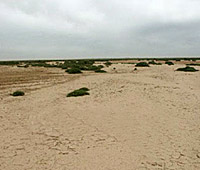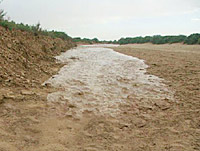Every spring, for as long as the residents of Beijing and neighboring Tianjin can remember, the two cities have been scraped raw by sandstorms sweeping down from the north. Vast areas of northern China have become deserts and winds sweeping down from Russia pick up the sand particles and deposit them on city streets, and the people in them. That, at least has been the conventional theory for the annual gritty misery.
But, the China Youth Daily recently published a letter jointly signed by some scientists putting forward a new idea about the origin of the storms. According to their analysis, they are dust, not sand, storms and dried up lakes near the cities are the root of the trouble. This new idea, and the possible need to change the way the problem is being tackled, has drawn nationwide attention, so reporters from the newspaper interviewed Liu Tuo, director of the Office of the State Forestry Administration.
"The experts' style of exploring a new way of sand control deserves commendation, and their suggestion plays an important role in wind and sand source control," said Liu. However, he felt the research was far from complete and dried-up lakes could not yet be considered the root of the trouble.
"Currently, wind and sand sources are being controlled comprehensively. The overall plan of sand control has been formed through many years of exploration and widely expounded by numerous experts that has stood the test of time," Liu said.

The wind and sand source control project in Beijing and Tianjin started trial operation in June 2000 and was carried out comprehensively last year, becoming one of the country's top six forestry projects. (The other five projects involve protecting natural forests; building a 20-million-hectare "shelter" belt of trees in northwest, north and northeast China and the middle and lower reaches of the Yangtze River; converting farmland to forest and grassland in the vast, but ecologically fragile western China; wildlife protection; and construction of nature reserves and forest industry bases)
.
Through various kinds of biological and engineering measures, the project is aimed at controlling desertification and reducing the damage caused by sandstorms. It is expected to take 10 years to finally improve the ecological environment in the areas surrounding Beijing and Tianjin.
The engineering construction covers Beijing, Tianjin, Hebei and Shanxi provinces and Inner Mongolia Autonomous Region. The planned forest will have an area of 110 million mu (1 hectare equals 15 mu). Some 160 million mu of grasslands will be replanted and more than 85 million mu protected.
Liu held that wind and sand in Beijing and Tianjin mainly originates from neighboring farming and stockbreeding crossing areas, over-cultivated areas, degenerating grasslands, deserts and river valleys. The river valleys include dried-up lakes. However, dried-up lakes are only one aspect, and not the main contributory factor. Currently, to control the wind and sand, some measures are adopted including reforesting cultivated land, improving grasslands and harnessing small rivers. Only this kind of overall distribution and comprehensive harnessing can gradually restore the ecological environment in these areas, and thus lessen and prevent the dusty spring weather in Beijing and Tianjin.
"The problem of dried-up lakes around Beijing and Tianjin is not very obvious," said Liu. In addition, dried-up lakes are being harnessed comprehensively. For example, the previous dried-up Juyan Lake in the Alashan area has been refilled with water and its nearby ecology is recovering.

Han Tonglin, a researcher from the Chinese Academy of Geological Sciences, is one of the scientists who put forward the idea that dried-up lakes were primarily to blame. "We put forward the idea through on-the-spot investigation and studies, and from the angle of geology, so the idea is indisputable," he insisted. Maybe desertification was the main problem in some localities, he conceded, but for Beijing and Tianjin, dried-up lakes are the main source of trouble. Degenerating grasslands can be restored through years without any grazing; however, it is very difficult to reverse the deterioration of dried-up lakes.
"We hope related experts can join the discussion of the idea," said Han. "We are organizing experts to discuss the harnessing of dried-up lakes, and a preliminary plan has been made. We hope Beijing won't suffer from dust storms by 2008 through effective control measures."
(China.org.cn translated by Li Jingrong October 16, 2003)

